The Snapdragon 845 Performance Preview: Setting the Stage for Flagship Android 2018
by Ryan Smith & Andrei Frumusanu on February 12, 2018 12:30 AM EST- Posted in
- Mobile
- Snapdragon
- Qualcomm
- Smartphones
- SoCs
- Snapdragon 845
System Performance
To see how the new CPUs and memory subsystem translate into more real system performance, we move onto more representative tests such as PCMark. PCMark’s performance is affected by several factors: not only does raw performance of the hardware count but also we need to consider the individual system’s software stack. We’ve seen large differences between Android OS major versions where the improvements of the Android Runtime can be directly visible in subtests such as the Writing test. Also a SoC’s DVFS schemes and schedulers can have huge impacts on “performance-latency”, meaning how fast the CPUs can ramp up a workload. This directly translates in a lot more performance in several of PCMark’s subtests as in the default settings none of the tests actually represent the pure performance of the CPU if it were locked at maximum frequency on the performance cores. The results of the tests are also overall a good representation of “snappiness” of a device.
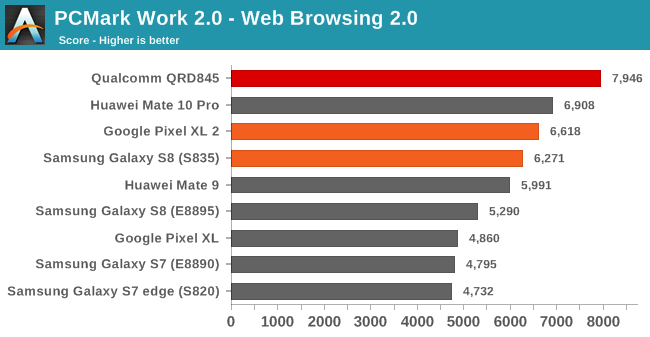
In the web browsing test the Snapdragon 845 QRD manages to outpace the Pixel 2 XL by 20%. Here we’re also looking at performance across devices with different OS versions. The Google devices are running Android 8.1 while the Samsung devices were tested with Android 7.0. The Mate 10 Pro runs Android 8.0 while the Mate 9 still had 7.0. The Qualcomm QRD we tested ran Android 8.0.
Again the performance increase over Snapdragon 835 devices isn’t all that great. DynamiQ allows for far more efficient thread transitions between the CPU cores and subsequently I expected Qualcomm to take advantage of this through more aggressive scheduling resulting in more than just a 20% increase. The difference between the Mate 9 and Mate 10 here is a good example of what a software configuration change can bring in terms of performance (both devices employ same performance CPU configurations). Samsung’s Exynos’ SoCs still use GTS scheduling and have non-optimal performance-latency resulting in bad scores, amplified by the fact that Samsung’s memory performance is also underwhelming when compared to the Snapdragon and Kirin SoCs.

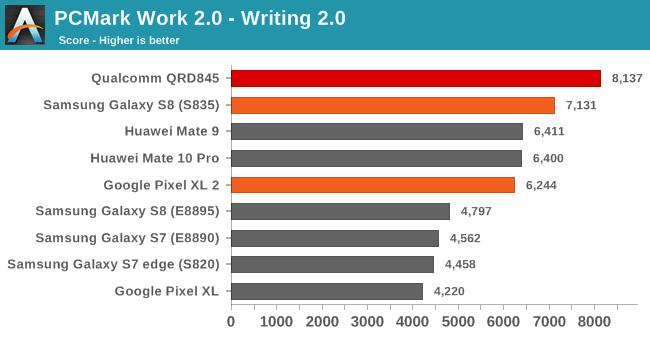
The Data Manipulation and Writing 2.0 tests make heavy use of the Android runtime and APIs and also a very memory latency sensitive. Between the best showings of the Snapdragon 835 variant of the S8 and the Pixel 2 XL in each respective benchmark, the Snapdragon QRD845 showed conservative increases of 8 to 14%. The Exynos SoCs lacklustre performance is again hampered by software and by bad memory performance.
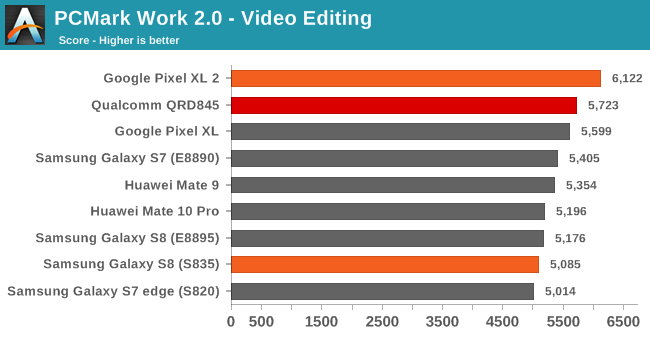
The video editing test is PCMark’s weak-point as it’s bottlenecked by things such as OS API overhead, and why we see tight grouping of performance results across a large range of SoCs. The Snapdragon 845 ends up high, but below the Pixel 2 XL. I would not put much weight on the results of this test as they’re not necessarily representative. Futuremark claims that the test is a lot more sensitive in mid- and low-range devices which can exhibit performance issues.
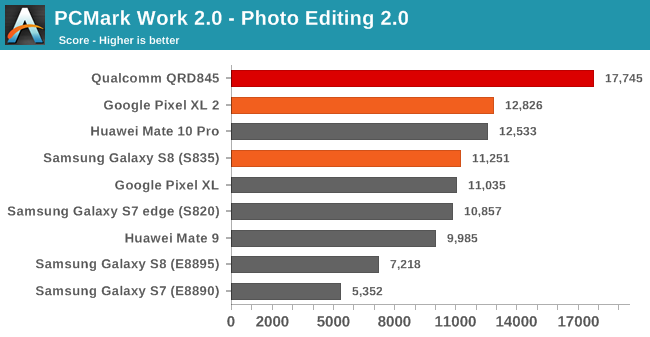
The photo editing test makes heavy use of Renderscript and use GPU acceleration to apply various effects on an image set. The QRD845 here shines as it’s able to showcase a 38% performance improvement over the Pixel 2 XL. Again the test not solely tests the raw performance of the system but also how optimized it is in terms of the software stack. This can be seen in the Kirin vs Exynos devices as Huawei’s phones vastly outperform Samsung’s devices in this test.
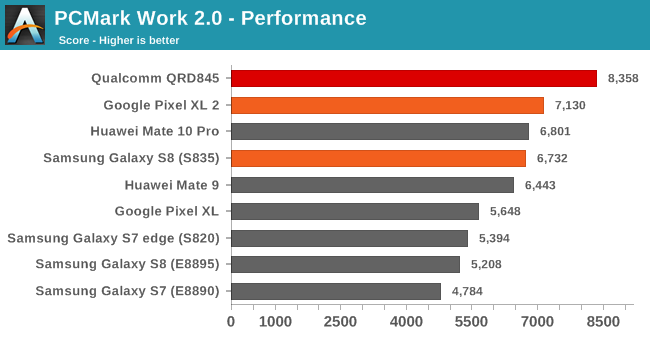
Overall PCMark’s performance score for the QRD845 increases by 17% over the Pixel 2 XL. Disregarding the video test, we see a similar scenario as in the synthetic tests as the new SoC’s CPU performance increases are lower than we had expected. Still the Snapdragon 845 is able to top the charts and should adequately power 2018’s flagship devices.
For 2018 we are reviewing our mobile benchmarking suite and altering some of the benchmarks we use. One of the changes in the way we benchmark devices is that we’re moving away from standalone browser and rather are benchmarking the OS’s WebView implementations. In general this seems to be a better choice for testing device experience as there is a lot of content that is being consumed via WebView windows. We also avoid the argument about different browser performance and since Google has now made WebView an updatable Play Store component we should also have valid comparisons older devices and systems. On the iOS side we do the same as we now benchmark browser tests within a WkWebView shell.
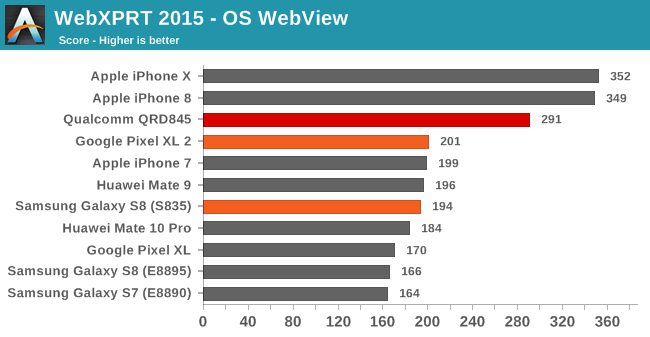
Starting off with WebXPRT 2015 for a last time before we’ll retire it in favour of WebXPRT 3, we see the QRD845 performing fantastically. Here the 44% performance increase over the Pixel 2 XL is a lot more in line with what we had expected of the new SoC. The QRD845 is even able to catch up a lot with Apple’s newest A11 and Monsoon cores in this test.
To keep up with the ever changing landscape of the developing web, we’re also retiring past JavaScript benchmarks in favour of a brand new and more representative benchmark developed by the WebKit team and welcomed by Google; Speedometer 2.0.

Here the Snapdragon 845 showcased another healthy performance increase of 37% over the Snapdragon 835 devices. Apple’s superior JavaScript performance can be attributed to a much faster and more optimized Nitro engine while Google’s V8 has only seen meagre improvements over the years. Notable is the Apple A11’s massive performance jump over the A10 – vastly increasing the distance to Android devices.










140 Comments
View All Comments
yhselp - Wednesday, February 14, 2018 - link
Wow. That's... Fingers crossed!lilmoe - Tuesday, February 13, 2018 - link
Would it be possible to completely disable the A75 cores and test the A55s alone to see the performance improvements compared to the A53s? That, in my opinion is a more meaningful comparison since your phone is running on the small cluster most of the time.Andrei Frumusanu - Tuesday, February 13, 2018 - link
We've done that in the past and I'll do it once I get my hands on devices.Hotstar Download - Wednesday, February 14, 2018 - link
How to balance https://uniqsofts.com/blogs/vidmate-online memory spaceyhselp - Wednesday, February 14, 2018 - link
Is it possible to update us on the status of a possible iPhone X/8 review - is it in the works, or has it been decided you won't be publishing one? Any interesting, technical insight into why it's taking longer than usual would be much appreciated, and fascinating to read. To be clear: I'm just asking politely, and not complaining.Andrei Frumusanu - Wednesday, February 14, 2018 - link
Hello, there is no technical reason for the delay; our former mobile editor Matt Humrick has left AT last summer. Ryan has not had the time to work on them alongside his editorial responsibilities. I re-joined AT at the very end of December and there was a lot of mobile back-log work to be done. I've only recently got to integrate data on the iPhones such as in this article.At this point in time it's highly unlikely the X/8 will get dedicated reviews but I will be integrating the data from the devices in other reviews. I will try to post an update on battery life and general update- camera comparisons will be included in the next device reviews.
Andrei Frumusanu - Wednesday, February 14, 2018 - link
* at the very end of November I meant to write.yhselp - Wednesday, February 14, 2018 - link
Thank you for taking the time to respond, and shed light on the matter. Unpredictable things happen. Looking forward to seeing the data in other reviews, sustained performance in particular. I wonder whether the glass back is a detriment, thermally, compared to aluminum on older iPhones.serendip - Wednesday, February 14, 2018 - link
Being a cheapskate techie, I'm more interested to see what future midrange 6xx parts will look like. For me, flagship 8xx SoCs are overkill and I'm not willing to pay to play in that range. A quad-A55 and dual-A75 design could be a big midrange hit like the old Snapdragon 650.Wardrive86 - Thursday, February 15, 2018 - link
Snapdragon 640 : 2 x 2.15 ghz Kryo 360 Gold, 6 x 1.55 GHz Kryo 360 Silver, 1 mb L3, 1 mb system cache, Adreno 610, dual channel lpddr4xSnapdragon 670 : 4 x 2 ghz Kryo 360 Gold, 4 x 1.6 ghz Kryo 360 Silver, 1 mb L3, 2 mb system cache, Adreno 620, triple channel lpddr4x.